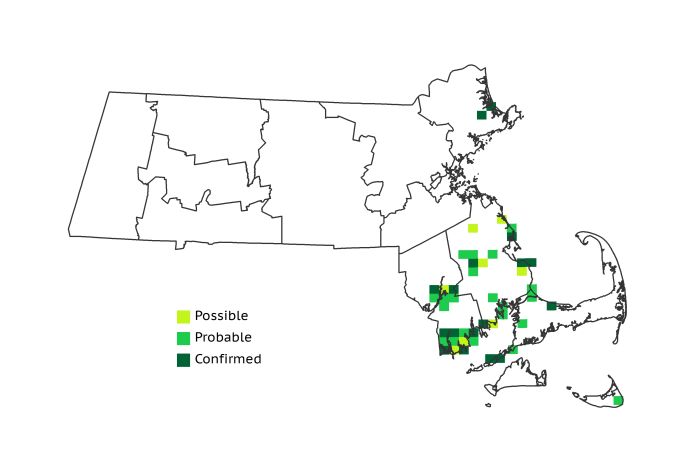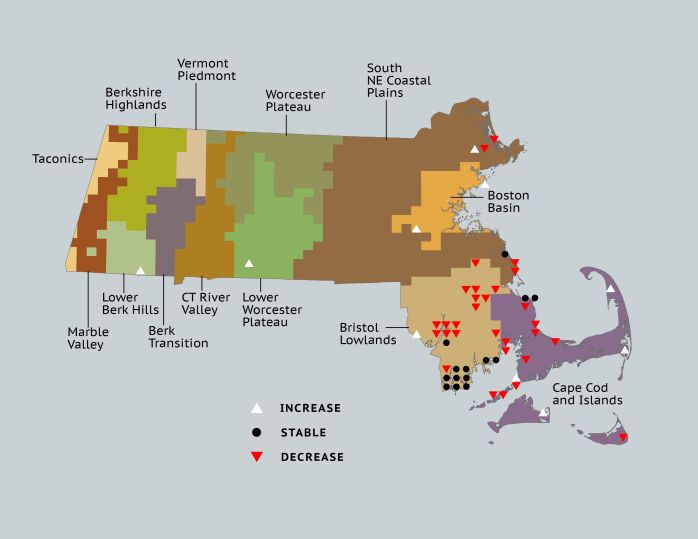Breeding Bird Atlases (BBA)
Find a Bird
White-eyed Vireo
Vireo griseus

Local and strongly declining
Conservation action urgent
“I meet [the White-eyed Vireo] only in the thick, bushy growths of low, swampy localities, where, eluding the observer, it pours forth its song with a sharpness and a rapidity of articulation that are truly astonishing.” – John Burroughs, Wake-Robin
Like most of its clan, the White-eyed Vireo tends to be shy and inconspicuous much of the time. During the breeding season, the harshly whistled song of the species proclaims its presence even when it remains unseen. Of the five breeding vireo species in the state, this one is the least often encountered. Still, White-eyed Vireos have long maintained a continuous presence in Massachusetts; however, their future is increasingly uncertain.
Historic Status
White-eyed Vireos teeter on the northeastern fringe of their breeding range in Massachusetts, and as such their historical presence has varied through the years. Prior to 1880, when the species was a regular breeder in Massachusetts during the spring and summer, all seemed well (Peabody 1839). In the years that followed, however, a decline began that culminated in near extirpation from the state by the 1950s. By 1955, Westport was the only town that could boast of having nesting White-eyed Vireos, when previously the species had nested at least sporadically in all but one county in the Commonwealth (Griscom & Snyder 1955). By 1970 a slow recovery had begun, but, since its required breeding habitat in Massachusetts had not substantially changed, the question became, why the decline? To date, no adequate answer has been forthcoming.
Atlas 1 Distribution
With the exception of a pair of blocks on the North Shore, the White-eyed Vireo population in Massachusetts was completely restricted to the southeastern part of the state in Atlas 1. Regenerating forests and spreading development had created a considerable reduction in the historic breeding range of this wet-scrub species. The Coastal Plains accounted for just 5 blocks, 3 of which were clustered together in northeastern Plymouth County. The most important ecoregion for this species during Atlas 1 was the Bristol/Narragansett Lowlands, which accounted for 63% of total occupied blocks statewide. Records from Cape Cod and the Islands made up the difference for this species, with notable concentrations on the Upper Cape and the Elizabeth Islands.
Atlas 2 Distribution and Change
The distribution of White-eyed Vireo thinned noticeably between Atlas 1 and Atlas 2. On one hand, the species was documented much farther west than it had been previously, with 1 occupied block in each of the Lower Berkshire Hills and the Worcester Plateau regions. The continued presence of the species on the North Shore and a new block in the Boston Basin even suggested that they may have been poised for expansion. However, a cursory glance at the species’ southeastern “home front” makes it clear that this was not the case. The species vanished from 15 previously occupied blocks in the Bristol/Narragansett Lowlands (almost half of its entire state distribution), and from more than half of formerly occupied Cape and Islands blocks when comparing the best-surveyed blocks. Minuscule gains in these regions did not offset their large and alarming losses. At the close of Atlas 2, the extreme southwest of the Bristol/Narragansett Lowlands appeared to be the only remaining refuge left for the White-eyed Vireo in Massachusetts.
Atlas 1 Map

Atlas 2 Map

Atlas Change Map

Ecoregion Data
Atlas 1 | Atlas 2 | Change | ||||||
Ecoregion | # Blocks | % Blocks | % of Range | # Blocks | % Blocks | % of Range | Change in # Blocks | Change in % Blocks |
Taconic Mountains | 0 | 0.0 | 0.0 | 0 | 0.0 | 0.0 | 0 | 0.0 |
Marble Valleys/Housatonic Valley | 0 | 0.0 | 0.0 | 0 | 0.0 | 0.0 | 0 | 0.0 |
Berkshire Highlands | 0 | 0.0 | 0.0 | 0 | 0.0 | 0.0 | 0 | 0.0 |
Lower Berkshire Hills | 0 | 0.0 | 0.0 | 1 | 3.2 | 3.1 | 1 | 3.7 |
Vermont Piedmont | 0 | 0.0 | 0.0 | 0 | 0.0 | 0.0 | 0 | 0.0 |
Berkshire Transition | 0 | 0.0 | 0.0 | 0 | 0.0 | 0.0 | 0 | 0.0 |
Connecticut River Valley | 0 | 0.0 | 0.0 | 0 | 0.0 | 0.0 | 0 | 0.0 |
Worcester Plateau | 0 | 0.0 | 0.0 | 1 | 1.1 | 3.1 | 0 | 0.0 |
Lower Worcester Plateau | 0 | 0.0 | 0.0 | 1 | 1.3 | 3.1 | 1 | 1.9 |
S. New England Coastal Plains and Hills | 5 | 1.9 | 10.9 | 4 | 1.4 | 12.5 | -3 | -1.3 |
Boston Basin | 0 | 0.0 | 0.0 | 2 | 3.6 | 6.3 | 2 | 3.6 |
Bristol and Narragansett Lowlands | 29 | 27.4 | 63.0 | 13 | 11.4 | 40.6 | -15 | -14.9 |
Cape Cod and Islands | 12 | 8.8 | 26.1 | 10 | 6.9 | 31.3 | -6 | -5.0 |
Statewide Total | 46 | 4.7 | 100.0 | 32 | 3.1 | 100.0 | -20 | -2.4 |
Notes
The White-eyed Vireo shows a significant decreasing Breeding Bird Survey (BBS) trend in the New England/Mid-Atlantic Region, but also shows a significant increasing BBS trend in the Eastern US overall.



